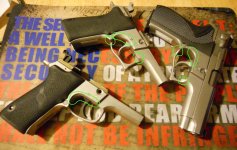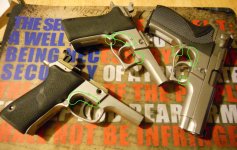I am just curious as I thought the variances in the frames of the 3 5906's I have.
In the picture, the oldest is the frame in the center dated Oct of '88, (TCB****). On this one, you will see that I have circled the areas of interest. The squared corners of the trigger guard and the beveled edge of the frame around the upper trigger guard.
The frame on the right is Mar of '90, (TES****). You will see the smooth round transition from the trigger guard to the frame and then the frame portion of the trigger guard where the frame isn't beveled as much as the other two frames.
The frame on the left is from November of 96, (VZC****). It's trigger guard is obvious, but what is of curiosity is bevel of the frame around the trigger guard and I must also mention that it has a slight radius to it also, unlike the '88 frame.
I am just curious as this is something I noticed.
In the picture, the oldest is the frame in the center dated Oct of '88, (TCB****). On this one, you will see that I have circled the areas of interest. The squared corners of the trigger guard and the beveled edge of the frame around the upper trigger guard.
The frame on the right is Mar of '90, (TES****). You will see the smooth round transition from the trigger guard to the frame and then the frame portion of the trigger guard where the frame isn't beveled as much as the other two frames.
The frame on the left is from November of 96, (VZC****). It's trigger guard is obvious, but what is of curiosity is bevel of the frame around the trigger guard and I must also mention that it has a slight radius to it also, unlike the '88 frame.
I am just curious as this is something I noticed.
Attachments
Last edited:


